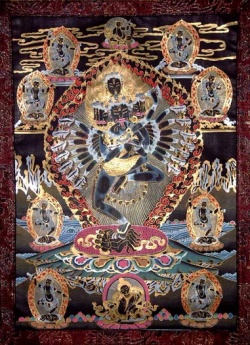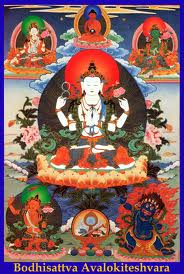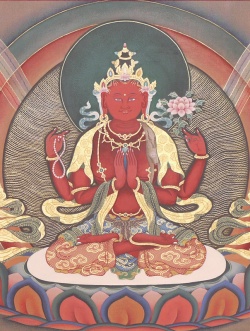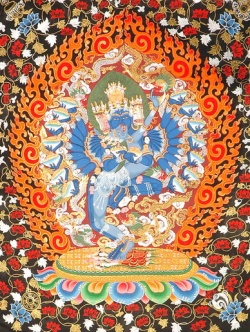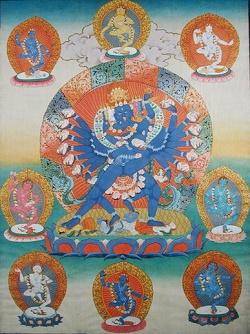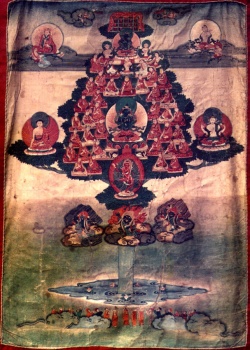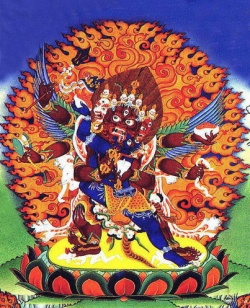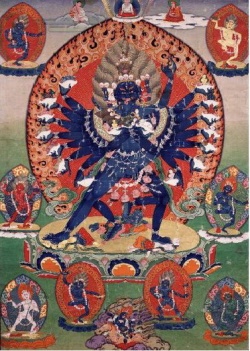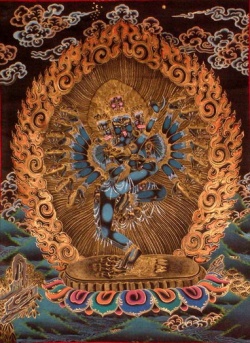Difference between revisions of "Hevajra 喜金刚"
(Created page with "thumb|250px| <poem> '''Hevajra''' (Tibetan: ཀྱེའི་རྡོ་རྗེ་ ''kye'i rdo rje'' / ''kye rdo rje''; Chinese: 喜金刚 Xǐ jīn...") |
|||
| Line 1: | Line 1: | ||
[[File:Hevajrah99.jpg|thumb|250px|]] | [[File:Hevajrah99.jpg|thumb|250px|]] | ||
<poem> | <poem> | ||
| − | '''Hevajra''' (Tibetan: ཀྱེའི་རྡོ་རྗེ་ ''kye'i rdo rje'' / ''kye rdo rje''; Chinese: 喜金刚 Xǐ jīngāng;) is one of the main yidams (enlightened beings) in Tantric, or Vajrayana Buddhism. Hevajra's consort is Nairātmyā (Tibetan: bdag med ma). | + | '''[[Hevajra]]''' ([[Tibetan]]: {{BigTibetan|[[ཀྱེའི་རྡོ་རྗེ་]]}} ''[[kye'i rdo rje]]'' / ''[[kye rdo rje]]''; [[Chinese]]: [[喜金刚]] [[Xǐ jīngāng]];) is one of the [[main yidams]] ([[enlightened beings]]) in [[Tantric]], or [[Vajrayana Buddhism]]. [[Hevajra's consort]] is [[Nairātmyā]] ([[Tibetan]]: [[bdag med ma]]). |
History | History | ||
| − | India | + | [[India]] |
| − | The Hevajra Tantra, a yoginītantra of the anuttarayogatantra class, is believed to have originated between the late eighth century CE. (Snellgrove[1]), and the "late ninth or early tenth century" (Davidson[2]), in Eastern India, possibly Bengal.Tāranātha lists Saroruha and Kampala (also known as "Lva-va-pā, "Kambhalī", and "Śrī-prabhada") as its "bringers": | + | The [[Hevajra Tantra]], a [[yoginītantra]] of the [[anuttarayogatantra]] class, is believed to have originated between the late eighth century CE. (Snellgrove[1]), and the "late ninth or early tenth century" (Davidson[2]), in Eastern [[India]], possibly Bengal.Tāranātha lists [[Saroruha]] and [[Kampala]] (also known as "[[Lva-va-pā]], "[[Kambhalī]]", and "[[Śrī-prabhada]]") as its "bringers": |
| − | .. the foremost yogi Virūpā meditated on the path of Yamāri and attained siddhi under the blessings of Vajravārāhi,...His disciple Dombi Heruka..understood the essence of the Hevajra Tantra, and composed many śāstras like the Nairātmā-devi-sādhana and the Sahaja-siddhi. He also conferred abhiṣeka on his own disciples. After this, two ācāryas Lva-va-pā and Saroruha brought the Hevajra Tantra. ... Siddha Sarouha was the first to bring the Hevajra-pitṛ-sādhana[3] | + | .. the foremost [[yogi]] [[Virūpā]] [[meditated]] on the [[path]] of [[Yamāri]] and [[attained]] [[siddhi]] under the [[blessings]] of Vajravārāhi,...His [[disciple]] [[Dombi]] Heruka..understood the [[essence]] of the [[Hevajra Tantra]], and composed many [[śāstras]] like the Nairātmā-devi-sādhana and the [[Sahaja-siddhi]]. [[He]] also conferred [[abhiṣeka]] on his [[own]] [[disciples]]. After this, two [[ācāryas]] [[Lva-va-pā]] and [[Saroruha]] brought the [[Hevajra Tantra]]. ... [[Siddha]] [[Sarouha]] was the first to bring the [[Hevajra-pitṛ-sādhana]][3] |
| − | Another lineage, mentioned by Kongtrul, goes from Vilāśyavajra to Anangavajra to Saroruha and thence to Indrabhuti. | + | Another [[lineage]], mentioned by Kongtrul, goes from [[Vilāśyavajra]] to [[Anangavajra]] to [[Saroruha]] and thence to [[Indrabhuti]]. |
| − | Jamgon Amyeshab, the 28th throne holder of Sakya, considers the Hevajra Tantra to have been revealed to Virupa by the Nirmanakaya Vajranairatma. This tantra is also considered by him to have been revealed to Dombhi Heruka, Virupa's senior disciple, by Nirmanakaya Vajranairatma, from whom the main Sakya exegetical lineage of the Hevajra tantra descends.[4] | + | [[Jamgon Amyeshab]], the [[28th throne holder of Sakya]], considers the [[Hevajra Tantra]] to have been revealed to [[Virupa]] by the [[Nirmanakaya]] [[Vajranairatma]]. This [[tantra]] is also considered by him to have been revealed to [[Dombhi Heruka]], [[Virupa's]] senior [[disciple]], by [[Nirmanakaya]] [[Vajranairatma]], from whom the main [[Sakya]] {{Wiki|exegetical}} [[lineage]] of the [[Hevajra tantra]] descends.[4] |
| − | The Yogaratnamālā, arguably the most important of the commentaries on the Hevajratantra, was written by one Kṛṣṇa or Kāṇha, who taught Bhadrapada, another commentator, who in turn taught Tilopa, the teacher of Nāropa, who himself wrote a commentary. He, in turn, passed on his knowledge of this tantra to Marpa (1012-1097 AD), who also taught in Tibet. Marpa also received instruction in the Hevajratantra from Maitrīpa, alias Advayavajra, who was banished fromVikramaśilā for practicing with a yoginī during the time of Atīśa's abbothood. | + | The [[Yogaratnamālā]], arguably the most important of the commentaries on the [[Hevajratantra]], was written by one [[Kṛṣṇa]] or [[Kāṇha]], who [[taught]] [[Bhadrapada]], another commentator, who in turn [[taught]] [[Tilopa]], the [[teacher of Nāropa]], who himself wrote a commentary. [[He]], in turn, passed on his [[knowledge]] of this [[tantra]] to [[Marpa]] (1012-1097 AD), who also [[taught]] in [[Tibet]]. [[Marpa]] also received instruction in the [[Hevajratantra]] from [[Maitrīpa]], alias [[Advayavajra]], who was banished fromVikramaśilā for practicing with a [[yoginī]] during the [[time]] of [[Atīśa's]] abbothood. |
[[File:Im245.jpg|thumb|250px|]] | [[File:Im245.jpg|thumb|250px|]] | ||
| − | Tibet | + | [[Tibet]] |
| − | Some time in the early 11th century, Drogmi Lotsawa Shākya Yeshe ('brog mi lo ts'a ba sh'akya ye shes) (993-1077 AD) journeyed from Drompa-gyang inLhatsé to Nepal and India, including Vikramaśilā, where he received instruction in the Hevajratantra from Śānti-pa (Ratnākaraśānti) and later to Bengal, where he encountered Prajñedraruci (Vīravajra) who instructed him in the "rootlessMargapala" (Tib. Lamdré) that is particularly concerned with the Hevajra tantra and its commentaries. Drakpa Gyeltsen writes in his Chronicle of the Indic Masters: | + | Some [[time]] in the early 11th century, [[Drogmi Lotsawa Shākya Yeshe]] ('[[brog mi lo ts'a ba sh'akya ye shes]]) (993-1077 AD) journeyed from [[Drompa-gyang]] inLhatsé to [[Nepal]] and [[India]], [[including]] [[Vikramaśilā]], where he received instruction in the [[Hevajratantra]] from [[Śānti-pa]] ([[Ratnākaraśānti]]) and later to {{Wiki|Bengal}}, where he encountered [[Prajñedraruci]] ([[Vīravajra]]) who instructed him in the "rootlessMargapala" (Tib. [[Lamdré]]) that is particularly concerned with the [[Hevajra tantra]] and its commentaries. [[Drakpa Gyeltsen]] writes in his Chronicle of the [[Indic]] [[Masters]]: |
| − | Now Lachen [Drokmi] first went to Nepal and entered into the door of mantra through [the teacher] Bhāro Ham-thung. Then he went to India itself and, realizing that the Āchārya Ratnākaraśānti was both greatly remowned and learned, he heard extensively the Vinaya,Prajñapāramitā, and mantra. Then having gone to the eastern part of India, he encountered Bhikṣu Vīravajra, who was the greatest direct disciple of Durjayachandra, who himself had held the lineage of Āchārya Virūpa's own disciple, Ḍombiheruka. From Bhikṣu Vīravajra he heard extensively the mantra material of the three tantras of Hevajra, complete in all their branches. He also requested the many instruction manuals of Acintyakrama and so forth, so that he heard the "Lamdré without the fundamental text" (rtsa med lam 'bras) as well. In this way, Drokmi lived in India for twelve years and became a great translator.[5] | + | Now Lachen [[[Drokmi]]] first went to [[Nepal]] and entered into the door of [[mantra]] through [the [[teacher]]] [[Bhāro Ham-thung]]. Then he went to [[India]] itself and, [[realizing]] that the [[Āchārya]] [[Ratnākaraśānti]] was both greatly remowned and learned, he [[heard]] extensively the Vinaya,Prajñapāramitā, and [[mantra]]. Then having gone to the eastern part of [[India]], he encountered [[Bhikṣu Vīravajra]], who was the greatest direct [[disciple]] of [[Durjayachandra]], who himself had held the [[lineage]] of [[Āchārya]] [[Virūpa's]] [[own]] [[disciple]], [[Ḍombiheruka]]. From [[Bhikṣu Vīravajra]] he [[heard]] extensively the [[mantra]] material of the [[three tantras]] of [[Hevajra]], complete in all their branches. [[He]] also requested the many instruction manuals of [[Acintyakrama]] and so forth, so that he [[heard]] the "[[Lamdré without the fundamental text]]" ([[rtsa med lam 'bras]]) as well. In this way, [[Drokmi]] lived in [[India]] for twelve years and became a great [[translator]].[5] |
| − | After twelve years he returned to central Tibet, probably by 1030, translated the Hevajratantra into Tibetan, and taught, among others, Dkon mchog ryal po (1034-1102 AD), the founder of the Sa-skya Monastery in 1073 AD.[6] This was the beginning of the close relationship between the Sakya Order and the Hevajratantra. | + | After twelve years he returned to [[central Tibet]], probably by 1030, translated the [[Hevajratantra]] into [[Tibetan]], and [[taught]], among others, [[Dkon mchog ryal po]] (1034-1102 AD), the founder of the [[Sa-skya Monastery]] in 1073 AD.[6] This was the beginning of the close relationship between the [[Sakya Order]] and the [[Hevajratantra]]. |
| − | In the Blue Annals, Gos lotsawa suggests that both the Havajra as well as the Kalachakra Tantras are commentaries on, or introductions to, the Guhyasamāja.[7] | + | In the [[Blue Annals]], [[Gos lotsawa]] suggests that both the Havajra as well as the [[Kalachakra Tantras]] are commentaries on, or introductions to, the [[Guhyasamāja]].[7] |
| − | China | + | [[China]] |
| − | The Chinese version of the Hevajra Tantra (Taishō XVIII 892, p. 587-601)[1] was done by Fa-hu (Dharmapalā) at the Institute for Canonical Translations (Yi jing yuan) in the capital of the Northern Sung (960-1128 AD), Bian liang, present day Kaifeng in Henan province. The five-volume translation was presented to the Emperor Jen-tsung at the end of Zhi he 1 (11 February 1054- 30 January 1055 AD) .[8] The title of the Chinese version reads "The Scriptural Text of the Ritual of The Great King of the Teaching The Adamantine One with Great Compassion and Knowledge of the Void explained by Buddha." The preface reads: | + | The [[Chinese]] version of the [[Hevajra Tantra]] ([[Taishō]] XVIII 892, p. 587-601)[1] was done by [[Fa-hu]] ([[Dharmapalā]]) at the Institute for {{Wiki|Canonical}} Translations ([[Yi jing yuan]]) in the capital of the [[Northern Sung]] (960-1128 AD), [[Bian liang]], {{Wiki|present}} day [[Kaifeng]] in {{Wiki|Henan province}}. The five-volume translation was presented to the [[Emperor]] [[Jen-tsung]] at the end of Zhi he 1 (11 February 1054- 30 January 1055 AD) .[8] The title of the [[Chinese]] version reads "The [[Scriptural]] Text of the [[Ritual]] of The Great [[King]] of the [[Teaching]] The [[Adamantine]] One with [[Great Compassion]] and [[Knowledge]] of the [[Void]] explained by [[Buddha]]." The preface reads: |
[[File:Hevajra81.jpg|thumb|250px|]] | [[File:Hevajra81.jpg|thumb|250px|]] | ||
| − | From among the 32 sections of the general tantra of Mahāmāyā one has taken 2 rituals with Nairātmyā. Dharmapāla, Great Master who transmits Sanskrit (texts), thoroughly illuminated and enlightened with Compassion, Probationary Senior Lord of Imperial Banquets, Grandee of Imperial Banquets with the Honour of Silver and Blue, Tripiţaka from India in the West during the Sung, received the honour of translating it by Imperial Mandate.[9] | + | From among the 32 [[sections]] of the general [[tantra of Mahāmāyā]] one has taken 2 [[rituals]] with [[Nairātmyā]]. [[Dharmapāla]], [[Great Master]] who transmits [[Sanskrit]] (texts), thoroughly [[illuminated]] and [[enlightened]] with [[Compassion]], Probationary Senior [[Lord]] of {{Wiki|Imperial}} Banquets, Grandee of {{Wiki|Imperial}} Banquets with the Honour of {{Wiki|Silver}} and Blue, [[Tripiţaka]] from [[India]] in the [[West]] during the Sung, received the honour of translating it by {{Wiki|Imperial}} Mandate.[9] |
| − | West | + | [[West]] |
| − | The Hevajra Tantra became the first major Buddhist Tantra to be translated in its entirety into a Western language whenDavid Snellgrove published his The Hevajra Tantra: A Critical Study in 1959. This work is in two volumes, the first volume containing his introduction including an "apology" explaining why such a text is worthy of study (apparently because of the unsavory reputation the tantras had acquired in the West early in the 20th century. Writing in 1959 he was able to say "There is still a tendency to regard them as something corrupt, as belonging to the twilight of Buddhism"[10]) , and his slightly bowdlerized English translation (showing that, perhaps subconsciously, he did feel conflicted about some of the contents). The second volume contains his editions of the Sanskrit and Tibetan texts (the Tibetan text being taken from the snar thang Kengyur) as well as a Sanskrit text of the Yogaratnamālā. Another translation appeared in 1992 as The Concealed Essence of the Hevajra-tantra. by G.W. Farrow and I. Menon. This version contains the Sanskrit text and English Translation of the tantra as well as a complete English translation of theYogaratnamālā. An English translation from Fa-hu's Chinese version was made by Ch. Willemen in 1983 and published as "The Chinese Hevajratantra". | + | The [[Hevajra Tantra]] became the first major [[Buddhist Tantra]] to be translated in its entirety into a [[Western]] [[language]] whenDavid Snellgrove published his The [[Hevajra Tantra]]: A Critical Study in 1959. This work is in two volumes, the first volume containing his introduction [[including]] an "[[apology]]" explaining why such a text is [[worthy]] of study (apparently [[because of]] the unsavory reputation the [[tantras]] had acquired in the [[West]] early in the 20th century. [[Writing]] in 1959 he was [[able]] to say "There is still a tendency to regard them as something corrupt, as belonging to the {{Wiki|twilight}} of [[Buddhism]]"[10]) , and his slightly bowdlerized English translation (showing that, perhaps subconsciously, he did [[feel]] conflicted about some of the contents). The second volume contains his editions of the [[Sanskrit]] and [[Tibetan texts]] (the [[Tibetan text]] [[being]] taken from the [[snar thang Kengyur]]) as well as a [[Sanskrit]] text of the [[Yogaratnamālā]]. Another translation appeared in 1992 as The Concealed [[Essence]] of the [[Hevajra-tantra]]. by [[G.W. Farrow]] and [[I. Menon]]. This version contains the [[Sanskrit]] text and English Translation of the [[tantra]] as well as a complete English translation of theYogaratnamālā. An English translation from [[Fa-hu's]] [[Chinese]] version was made by [[Ch. Willemen]] in 1983 and published as "The [[Chinese]] [[Hevajratantra]]". |
Text | Text | ||
| − | Originally written in mixed quality Sanskrit (with some verses in Apabhraṃśa), the present 750 verse text is reported to be but an excerpt or summary of a much larger, original text of up to 500,000 ślokas (verses) in 32 sections. Many Buddhist texts claim to be condensations of much larger missing originals, with most of the alleged originals either never having been found, or perhaps conceived of as "virtual" texts that exist permanently in some disembodied way. However, the existence of the 100,000 verse Prajnaparamita Sutra shows that works of such proportions were actually produced. | + | Originally written in mixed [[quality]] [[Sanskrit]] (with some verses in [[Apabhraṃśa]]), the {{Wiki|present}} 750 verse text is reported to be but an excerpt or summary of a much larger, original text of up to 500,000 [[ślokas]] (verses) in 32 [[sections]]. Many [[Buddhist texts]] claim to be condensations of much larger missing originals, with most of the alleged originals either never having been found, or perhaps [[conceived]] of as "virtual" texts that [[exist]] permanently in some disembodied way. However, the [[existence]] of the 100,000 verse [[Prajnaparamita Sutra]] shows that works of such proportions were actually produced. |
[[File:Gyalwa-Gyatso.jpg|thumb|250px|]] | [[File:Gyalwa-Gyatso.jpg|thumb|250px|]] | ||
| − | The Hevajra Tantra has some material in common with other sources: II iii 29 of the Hevajratantra is the same as XVI 59c-60b of the Guhyasamajatantra, and an Apabhraṃśa couplet at II v 67 of the Hevajratantra appears in one of Saraha's songs. In the case of the Guhyasamaja, it is safe to assume that the Hevajra version is later, but the case is not as clear cut with the Saraha quote, since the relative dates are harder to establish with any certainty. | + | The [[Hevajra Tantra]] has some material in common with other sources: II iii 29 of the [[Hevajratantra]] is the same as XVI 59c-60b of the [[Guhyasamajatantra]], and an [[Apabhraṃśa]] couplet at II v 67 of the [[Hevajratantra]] appears in one of [[Saraha's]] [[songs]]. In the case of the [[Guhyasamaja]], it is safe to assume that the [[Hevajra]] version is later, but the case is not as clear cut with the [[Saraha]] quote, since the [[relative]] dates are harder to establish with any {{Wiki|certainty}}. |
| − | Root Tantra | + | [[Root Tantra]] |
Dvātriṃśatkalpoddhṛtaḥ kalpadvayātmako śrīhevajraḍākinījālasamvaramahātantrarājā | Dvātriṃśatkalpoddhṛtaḥ kalpadvayātmako śrīhevajraḍākinījālasamvaramahātantrarājā | ||
| − | Manuscripts in the National Archives, Kathmandu, Nepal | + | Manuscripts in the National Archives, [[Kathmandu]], [[Nepal]] |
No. 3-303. | No. 3-303. | ||
| Line 60: | Line 60: | ||
No. 4-71. | No. 4-71. | ||
| − | Manuscript in the Cambridge University Library, Add. 1340 | + | {{Wiki|Manuscript}} in the {{Wiki|Cambridge University}} Library, Add. 1340 |
| − | Manuscript belonging to the Asiatic Society of Bengal, no. 11317 | + | {{Wiki|Manuscript}} belonging to the [[Asiatic Society of Bengal]], no. 11317 |
| − | Manuscripts in the Tōkyō University Library: Nos 509-512[11] | + | Manuscripts in the [[Tōkyō University Library]]: Nos 509-512[11] |
Editions: | Editions: | ||
| Line 72: | Line 72: | ||
Farrow and Menon[13] | Farrow and Menon[13] | ||
| − | Tibetan: | + | [[Tibetan]]: |
| − | kye'i rdo rje zhes bya ba rgyud kyi rgyal po - Narthang Kangyur, snar thang 369, vol. 80, rgyud (ka) 306b-351b | + | [[kye'i rdo rje]] [[zhes bya ba rgyud kyi rgyal po]] - [[Narthang]] [[Kangyur]], [[snar thang]] 369, vol. 80, rgyud (ka) 306b-351b |
| − | colophon: rgyud kyi rgyal po sgyu ma'i brtag pa zhes bya ba brtag pa sum cu rtsa gnyis las phyung ba brtag pa gnyis kyi bdag nyid kye'i rdo rje mkha' 'gro ma dra ba'i sdom pa'i rgyud kyi rgyal po chen po rdzogs so/ /rgya gar gyi mkhan po ga ya d+ha ra'i zhal snga nas dang/ bod kyi lo ts+tsha ba dge slong shAkya ye shes kyis bsgyur cing zhus te gtan la phab pa/ | + | colophon: rgyud kyi [[rgyal po]] sgyu ma'i brtag pa [[zhes bya ba]] brtag pa sum cu rtsa [[gnyis]] las phyung ba brtag pa [[gnyis]] kyi [[bdag nyid]] [[kye'i rdo rje]] [[mkha' 'gro ma]] dra ba'i [[sdom]] pa'i rgyud kyi [[rgyal po chen po]] [[rdzogs]] so/ /[[rgya]] gar gyi [[mkhan po]] ga ya d+ha ra'i zhal snga nas dang/ bod kyi lo ts+tsha ba [[dge slong]] shAkya [[ye shes]] [[kyis]] bsgyur [[cing]] zhus te gtan la phab pa/ |
Edition: Snellgrove[12] | Edition: Snellgrove[12] | ||
| − | kye'i rdo rje zhes bya ba rgyud kyi rgyal po (Hevajratantrarājanāma) Tōh. 417, sDe-dge Kangyur rgyud 'bum vol. nga, 1b-13b | + | [[kye'i rdo rje]] [[zhes bya ba rgyud kyi rgyal po]] (Hevajratantrarājanāma) Tōh. 417, [[sDe-dge]] [[Kangyur]] [[rgyud 'bum]] vol. nga, 1b-13b |
| − | colophon: kye'i rdo rje mkha' 'gro ma dra ba'i sdom pa las rdo rje snying po mngon par byang chub zhes bya ba brtag pa'i rgyal po rdzogs so | + | colophon: [[kye'i rdo rje]] [[mkha' 'gro ma]] dra ba'i [[sdom pa]] las [[rdo rje]] [[snying po]] [[mngon par byang chub]] [[zhes bya ba]] brtag pa'i [[rgyal po]] [[rdzogs]] so |
| − | kye'i rdo rje zhes bya ba rgyud kyi rgyal po Urga Kangyur, urga 418, vol.79, rgyud (nga), 1r-30r | + | [[kye'i rdo rje]] [[zhes bya ba rgyud kyi rgyal po]] [[Urga Kangyur]], [[urga]] 418, vol.79, rgyud (nga), 1r-30r |
| − | colophon: rgyud kyi rgyal po chen po sgyu ma'i brtag pa zhes bya ba brtag pa sum cu rtsa gnyis las phyung pa brtag pa gnyis kyi bdag nyid kye'i rdo rje mkha' 'gro ma dra ba'i sdom pa'i rgyud kyi rgyal po rdzogs so/ /rgya gar gyi mkhan po ga ya d+ha ra'i zhal snga nas bod kyi lo ts+tsha ba dge slong shAkya ye shes kyis bsgyur cing zhus te gtan la phab pa/slar yang lo ts+tsha ba gzhon nu dpal gyis 'gyur chad bsabs shing dag par bgyis pa'o/ | + | colophon: rgyud kyi [[rgyal po chen po]] sgyu ma'i brtag pa [[zhes bya ba]] brtag pa sum cu rtsa [[gnyis]] las phyung pa brtag pa [[gnyis]] kyi [[bdag nyid]] [[kye'i rdo rje]] [[mkha' 'gro ma]] dra ba'i [[sdom]] pa'i rgyud kyi [[rgyal po]] [[rdzogs]] so/ /[[rgya]] gar gyi [[mkhan po]] ga ya d+ha ra'i zhal snga nas bod kyi lo ts+tsha ba [[dge slong]] shAkya [[ye shes]] [[kyis]] bsgyur [[cing]] zhus te gtan la phab pa/slar [[yang]] lo ts+tsha ba [[gzhon nu dpal]] gyis 'gyur chad bsabs [[shing]] dag par bgyis pa'o/ |
| − | kye'i rdo rje zhes bya ba rgyud kyi rgyal po Stog Palace Kangyur, stog 379, Volume 94, rgyud bum (ga), 107r-148v | + | [[kye'i rdo rje]] [[zhes bya ba rgyud kyi rgyal po]] [[Stog Palace]] [[Kangyur]], [[stog]] 379, Volume 94, rgyud [[bum]] (ga), 107r-148v |
[[File:Hevajra2as.jpg|thumb|250px|]] | [[File:Hevajra2as.jpg|thumb|250px|]] | ||
| − | colophon: rgyud kyi rgyal po sgyu ma'i brtag pa zhes bya ba brtag pa sum cu rtsa gnyis las phyung ba brtag pa gnyis kyi bdag nyid kye'i rdo rje mkha' 'gro ma dra ba'i sdom pa'i rgyud kyi rgyal po chen po rdzogs so/ /rgya gar gyi mkhan po ga ya d+ha ra'i zhal snga nas dang/ bod kyi lo tsa ba dge slong shAkya ye shes kyis bsgyur cing zhus te gtan la phab pa | + | colophon: rgyud kyi [[rgyal po]] sgyu ma'i brtag pa [[zhes bya ba]] brtag pa sum cu rtsa [[gnyis]] las phyung ba brtag pa [[gnyis]] kyi [[bdag nyid]] [[kye'i rdo rje]] [[mkha' 'gro ma]] dra ba'i [[sdom]] pa'i rgyud kyi [[rgyal po chen po]] [[rdzogs]] so/ /[[rgya]] gar gyi [[mkhan po]] ga ya d+ha ra'i zhal snga nas dang/ bod kyi [[lo tsa ba]] [[dge slong]] shAkya [[ye shes]] [[kyis]] bsgyur [[cing]] zhus te gtan la phab pa |
| − | kye'i rdo rje zhes bya ba rgyud kyi rgyal po Lhasa Kangyur, lhasa 380, volume 79, rgyud (ka), 672-761 | + | [[kye'i rdo rje]] [[zhes bya ba rgyud kyi rgyal po]] [[Lhasa Kangyur]], [[lhasa]] 380, volume 79, rgyud (ka), 672-761 |
| − | colophon: rgyud kyi rgyal po sgyu ma'i brtag pa zhes bya ba brtag pa sum cu rtsa gnyis las phyung ba brtag pa gnyis kyi bdag nyid kye'i rdo rje mkha' 'gro ma dra ba'i sdom pa'i rgyud kyi rgyal po chen po rdzogs so/ /rgya gar gyi mkhan po ga ya d+ha ra'i zhal snga nas bod kyi lo ts+tsha ba dge slong shAkya ye shes kyis bsgyur cing zhus te gtan la phab pa | + | colophon: rgyud kyi [[rgyal po]] sgyu ma'i brtag pa [[zhes bya ba]] brtag pa sum cu rtsa [[gnyis]] las phyung ba brtag pa [[gnyis]] kyi [[bdag nyid]] [[kye'i rdo rje]] [[mkha' 'gro ma]] dra ba'i [[sdom]] pa'i rgyud kyi [[rgyal po chen po]] [[rdzogs]] so/ /[[rgya]] gar gyi [[mkhan po]] ga ya d+ha ra'i zhal snga nas bod kyi lo ts+tsha ba [[dge slong]] shAkya [[ye shes]] [[kyis]] bsgyur [[cing]] zhus te gtan la phab pa |
| Line 100: | Line 100: | ||
Commentaries | Commentaries | ||
| − | Yogaratnamālā by Kāṇha | + | [[Yogaratnamālā]] by [[Kāṇha]] |
| − | Śrīhevajravyākhyākhyāvivaraṇa by Bhadrapāda | + | [[Śrīhevajravyākhyākhyāvivaraṇa]] by [[Bhadrapāda]] |
| − | Netravibhanga by Dharmakīrtī | + | [[Netravibhanga]] by Dharmakīrtī |
| − | Smṛtiniṣpatti (?) by Kāṇha | + | [[Smṛtiniṣpatti]] (?) by [[Kāṇha]] |
| − | Vajrapādasārasaṃgraha by Nāro | + | [[Vajrapādasārasaṃgraha]] by [[Nāro]] |
| − | Muktāvalī by Ratnākaraśānti | + | Muktāvalī by [[Ratnākaraśānti]] |
[[File:Golden-rosary-1.jpg|thumb|250px|]] | [[File:Golden-rosary-1.jpg|thumb|250px|]] | ||
| − | Sanskrit edition from five manuscripts by Ram Shankar Tripathi and Thakur Sain Negi in the series Bibliotheca Indo-Tibetica Series XLVIII, Central Institute for Higher Tibetan Studies, Sarnath, 2001. | + | [[Sanskrit]] edition from five [[manuscripts]] by [[Ram Shankar Tripathi]] and Thakur Sain Negi in the series Bibliotheca Indo-Tibetica Series XLVIII, Central Institute for Higher [[Tibetan Studies]], [[Sarnath]], 2001. |
| − | Padminī by Saroruha | + | [[Padminī]] by [[Saroruha]] |
Suviśuddhasaṃpuṭa by Ṭankadāsa | Suviśuddhasaṃpuṭa by Ṭankadāsa | ||
| − | Ṣaṭsāhasrikā-Hevajra-Ṭīkā by Daśabhūmīśvara Vajragharba | + | [[Ṣaṭsāhasrikā-Hevajra-Ṭīkā]] by [[Daśabhūmīśvara Vajragharba]] |
| − | Sanskrit edition from two incomplete mss, Tibetan edition, with English translation of Sanskrit portion and summary of remaining part, in Shendge, Malati J., 2004. Ṣaṭsāhasrikā-Hevajra-Ṭīkā: A Critical Edition. Pratibha Prakashan, Delhi. "On this shorter tantra of 750 verses containing many vajrapadas which is selected from abother big tantra of five lakhs (500,000) of verses, is revealed this commentary, which owes its inspiration to Hevajra and which is known to contain 6000 verses and following mulatantra, by the illustrious Vajragarbha." (1.4-6) | + | [[Sanskrit]] edition from two incomplete mss, [[Tibetan]] edition, with English translation of [[Sanskrit]] portion and summary of remaining part, in Shendge, Malati J., 2004. [[Ṣaṭsāhasrikā-Hevajra-Ṭīkā]]: A Critical Edition. [[Pratibha Prakashan]], {{Wiki|Delhi}}. "On this shorter [[tantra]] of 750 verses containing many [[vajrapadas]] which is selected from abother big [[tantra]] of five [[lakhs]] (500,000) of verses, is revealed this commentary, which owes its inspiration to [[Hevajra]] and which is known to contain 6000 verses and following [[mulatantra]], by the illustrious [[Vajragarbha]]." (1.4-6) |
| − | Explanatory Tantras | + | [[Explanatory Tantras]] |
| − | Ḍākinīvajrapañjaratantra | + | [[Ḍākinīvajrapañjaratantra]] |
| − | Saṃpuṭatantra | + | [[Saṃpuṭatantra]] |
[[File:Hevajra0445.jpg|thumb|250px|]] | [[File:Hevajra0445.jpg|thumb|250px|]] | ||
| − | Iconography | + | [[Iconography]] |
| − | Hevajra has four forms described in the Hevajra Tantra and four forms described the Samputa Tantra: | + | [[Hevajra]] has four [[forms]] described in the [[Hevajra Tantra]] and four [[forms]] described the [[Samputa Tantra]]: |
| − | Hevajra Tantra | + | [[Hevajra Tantra]] |
| − | Kaya Hevajra | + | [[Kaya Hevajra]] |
| − | The two armed Body (Kaya) Hevajra described in the Hevajra Tantra stands in an advancing posture on a multi-coloured lotus, corpse, and sun disk. He is dark blue in colour. His right hand holds a vajra club, and his left hand holds a vajra-marked skull cup. He embraces his consort Vajranairatma (rDo-rje bDag-med-ma). A khatvanga staff rests on his left shoulder and he is adorned with the six symbolic ornaments. | + | The two armed [[Body]] ([[Kaya]]) [[Hevajra]] described in the [[Hevajra Tantra]] stands in an advancing [[posture]] on a multi-coloured [[lotus]], corpse, and {{Wiki|sun}} disk. [[He]] is [[dark blue]] in {{Wiki|colour}}. His [[right]] hand holds a [[vajra club]], and his left hand holds a vajra-marked [[skull cup]]. [[He]] embraces his [[consort Vajranairatma]] ([[rDo-rje bDag-med-ma]]). A [[khatvanga staff]] rests on his left shoulder and he is adorned with the [[six symbolic ornaments]]. |
| − | In the Sadhanamala this form of Hevajra is single (ekavira) - without a consort.[14] | + | In the [[Sadhanamala]] this [[form]] of [[Hevajra]] is single ([[ekavira]]) - without a [[consort]].[14] |
| − | Vak Hevajra | + | [[Vak Hevajra]] |
| − | The four armed Speech (Vak) Hevajra described in the Hevajra Tantra stands in an advancing posture on a multi-coloured lotus, corpse, and sun disk. He is dark blue in colour. One right hand holds a vajra and one left hand a skullfull of blood, the other pair of arms embrace his consort Vajravarahi (rDo-rje phag-mo). | + | The four armed {{Wiki|Speech}} ([[Vak]]) [[Hevajra]] described in the [[Hevajra Tantra]] stands in an advancing [[posture]] on a multi-coloured [[lotus]], corpse, and {{Wiki|sun}} disk. [[He]] is [[dark blue]] in {{Wiki|colour}}. One [[right]] hand holds a [[vajra]] and one left hand a skullfull of {{Wiki|blood}}, the other pair of arms embrace his [[consort Vajravarahi]] ([[rDo-rje phag-mo]]). |
| − | Citta Hevajra | + | [[Citta Hevajra]] |
[[File:Heruka-Vajrakilaya.jpg|thumb|250px|]] | [[File:Heruka-Vajrakilaya.jpg|thumb|250px|]] | ||
| − | The six armed Mind (Citta) Hevajra described in the Hevajra Tantra stands in an advancing posture with right leg extended and left bent on a multi-coloured lotus, corpse, and sun disk. He is dark blue in colour with three faces - C. blue, R. white and L. red. Each face has three blood shot eyes and four bared fangs, and frowns with knotted brows. His tawny hair streams up surmounted with a crossed vajra.. Two right hands hold a vajra and a knife, two left a trident and a bell; the remaining pair of arms embrace his consort Vajrasrinkhala Hevajra is imbued with the nine dramatic sentiments and adorned with a diadem of five dry skulls, a necklace of fifty fresh heada and the six symbolic ornaments or 'seals'. | + | The six armed [[Mind]] ([[Citta]]) [[Hevajra]] described in the [[Hevajra Tantra]] stands in an advancing [[posture]] with [[right]] leg extended and left bent on a multi-coloured [[lotus]], corpse, and {{Wiki|sun}} disk. [[He]] is [[dark blue]] in {{Wiki|colour}} with three faces - C. blue, R. white and L. [[red]]. Each face has three {{Wiki|blood}} shot [[eyes]] and four bared fangs, and frowns with knotted brows. His tawny [[hair]] streams up surmounted with a [[crossed vajra]].. Two [[right]] hands hold a [[vajra]] and a knife, two left a [[trident]] and a [[bell]]; the remaining pair of arms embrace his [[consort]] [[Vajrasrinkhala]] [[Hevajra]] is imbued with the nine dramatic sentiments and adorned with a diadem of five dry skulls, a necklace of fifty fresh heada and the [[six symbolic ornaments]] or '[[seals]]'. |
| − | Hrdaya Hevajra | + | [[Hrdaya Hevajra]] |
| − | The sixteen-armed, four-legged eight-faced Heart (Hrdaya) Hevajra described in the Hevajra Tantra stands with two legs in ardha-paryanka and the other two in alidha posture (left bent, right extended) on a multi-coloured eight petalled lotus, the four Maras in the forms of yellow Brahma, black Vishnu, white Shiva (Mahesvara) and yellow Indra and a sun disc resting on their hearts. | + | The sixteen-armed, four-legged eight-faced [[Heart]] ([[Hrdaya]]) [[Hevajra]] described in the [[Hevajra Tantra]] stands with two {{Wiki|legs}} in [[ardha-paryanka]] and the other two in [[alidha]] [[posture]] (left bent, [[right]] extended) on a multi-coloured [[eight petalled lotus]], the [[four Maras]] in the [[forms]] of [[yellow]] [[Brahma]], black [[Vishnu]], white [[Shiva]] ([[Mahesvara]]) and [[yellow]] [[Indra]] and a {{Wiki|sun}} disc resting on their hearts. |
| − | Sri Hevajra is 16 years old, black in color, naked, with eight faces, sixteen arms and four legs. His central face is black, the first right white, the first left red, the upper face smoke-coloured and ugly; the outer two faces on each side, black. All have three round blood shot eyes, four bared fangs, a vibrating tongue, and frowning with knotted brows. His lustrous tawny hair streams upward crowned with a crossed vajra. He is adorned with a diadem of five dry skulls. The sixteen hands hold sixteen skull cups. The central pair of arms skull contain a white elephant and the yellow earth-goddess Prithvi, and embrace his consort Vajranairatma (rDo-rje bDag-med-ma) whose two legs encircle his body. Her right hands holds a curved knife (kartika), while the left is wrapped around the neck of her lord and holds a skullcup (kapala). In the other seven skull cups held in Hevajra's outer right hands are: a blue horse, a white-nosed ass, a red ox, an ashen camel, a red human, a blue sarabha deer, and an owl or cat. In the skull cups in the outer seven left hands are the white water-god Varuna, the green wind-god Vayu, the red fire-god Agni / Tejas, the white moon god Candra, the red sun godSurya or Aditya, blue Yama lord of death and yellow Kubera or Dhanada lord of wealth. Hevajra is adorned with the six symbolic ornaments: circlet, earrings, necklace, bracelets, girdle armlets and anklets and smeared with the ashes of the charnel ground. He wears a necklace of fifty freshly severed human heads. | + | [[Sri Hevajra]] is 16 years old, black in {{Wiki|color}}, naked, with eight faces, sixteen arms and four {{Wiki|legs}}. His central face is black, the first [[right]] white, the first left [[red]], the upper face smoke-coloured and ugly; the outer two faces on each side, black. All have three round {{Wiki|blood}} shot [[eyes]], four bared fangs, a vibrating {{Wiki|tongue}}, and frowning with knotted brows. His lustrous tawny [[hair]] streams upward crowned with a [[crossed vajra]]. [[He]] is adorned with a diadem of five dry skulls. The sixteen hands hold sixteen [[skull cups]]. The central pair of arms [[skull]] contain a [[white elephant]] and the [[yellow earth-goddess]] [[Prithvi]], and embrace his [[consort Vajranairatma]] ([[rDo-rje bDag-med-ma]]) whose two {{Wiki|legs}} encircle his [[body]]. Her [[right]] hands holds a [[curved knife]] ([[kartika]]), while the left is wrapped around the neck of her [[lord]] and holds a [[skullcup]] ([[kapala]]). In the other seven [[skull cups]] held in [[Hevajra's]] outer [[right]] hands are: a blue [[horse]], a white-nosed ass, a [[red]] ox, an ashen {{Wiki|camel}}, a [[red]] [[human]], a blue [[sarabha deer]], and an {{Wiki|owl}} or {{Wiki|cat}}. In the [[skull cups]] in the outer seven left hands are the white water-god {{Wiki|Varuna}}, the [[green]] wind-god {{Wiki|Vayu}}, the [[red]] [[fire-god]] [[Agni]] / [[Tejas]], the white [[moon god]] [[Candra]], the [[red]] {{Wiki|sun}} godSurya or [[Aditya]], blue [[Yama]] [[lord of death]] and [[yellow]] [[Kubera]] or [[Dhanada]] [[lord of wealth]]. [[Hevajra]] is adorned with the [[six symbolic ornaments]]: circlet, earrings, necklace, bracelets, girdle armlets and anklets and smeared with the ashes of the [[charnel ground]]. [[He]] wears a necklace of fifty freshly severed [[human]] heads. |
[[File:Hevajra02.jpg|thumb|250px|]] | [[File:Hevajra02.jpg|thumb|250px|]] | ||
Notes | Notes | ||
| Line 164: | Line 164: | ||
^ Chattopadhyana, 1970 pg 245-246 | ^ Chattopadhyana, 1970 pg 245-246 | ||
| − | ^ folio 49/a gsung nag rin po che byon tshul khog phub, vol Zha, gsung 'bum, Kathmandhu, 2000 | + | ^ folio 49/a [[gsung]] nag [[rin po che]] byon tshul khog [[phub]], vol Zha, [[gsung 'bum]], Kathmandhu, 2000 |
^ quoted in Davidson, 2004, p. 166 | ^ quoted in Davidson, 2004, p. 166 | ||
| − | ^ Roerich, Blue Annals, p. 205-211 | + | ^ [[Roerich]], [[Blue Annals]], p. 205-211 |
| − | ^ Roerich, 1949, vol. 1, pg 358 | + | ^ [[Roerich]], 1949, vol. 1, pg 358 |
^ Willemen, 1983, p.23-28 | ^ Willemen, 1983, p.23-28 | ||
| Line 190: | Line 190: | ||
References | References | ||
| − | Chattopadhyana, Debiprasad, ed. 1970 Taranatha's History of Buddhism in India. Indian Institute of Advanced Study, Simla | + | Chattopadhyana, Debiprasad, ed. 1970 [[Taranatha's]] [[History of Buddhism in India]]. {{Wiki|Indian Institute of Advanced Study}}, {{Wiki|Simla}} |
| − | Chandra, Lokesh. 2002. Dictionary of Buddhist Iconography. Delhi: Aditya Prakashan. | + | [[Chandra]], Lokesh. 2002. {{Wiki|Dictionary}} of [[Buddhist Iconography]]. {{Wiki|Delhi}}: [[Aditya Prakashan]]. |
Davidson, Ronald M. | Davidson, Ronald M. | ||
| − | 2002. "Indian Esoteric Buddhism: A Social History of the Tantric Movement." Columbia University Press, NY. | + | 2002. "[[Indian Esoteric Buddhism]]: A {{Wiki|Social}} History of the [[Tantric]] {{Wiki|Movement}}." [[Columbia University Press]], NY. |
| − | 2005. "Tibetan Renaissance: Tantric Buddhism in the Rebirth of Tibetan Culture." Columbia University Press, NY. | + | 2005. "[[Tibetan]] {{Wiki|Renaissance}}: [[Tantric Buddhism]] in the [[Rebirth]] of [[Tibetan]] {{Wiki|Culture}}." [[Columbia University Press]], NY. |
| − | Farrow, G.W. & Menon I. 1992. The Concealed Essence of the hevajra-tantra. Delhi: Motilal Banarasidas. | + | Farrow, G.W. & Menon I. 1992. The Concealed [[Essence]] of the [[hevajra-tantra]]. {{Wiki|Delhi}}: Motilal Banarasidas. |
| − | Finot, Louis. 1934. "Manuscrits sanscrits de sādhana retrouvés en Chine (Hevajrasekaprakriyā)." Journal Asiatique, 1-85. | + | Finot, Louis. 1934. "Manuscrits sanscrits de [[sādhana]] retrouvés en Chine (Hevajrasekaprakriyā)." [[Journal Asiatique]], 1-85. |
| − | Matsunami, S. 1965. "A Catalogue of the Sanskrit Manuscripts in the Tōkyō University Library." Tōkyō. | + | Matsunami, S. 1965. "A Catalogue of the [[Sanskrit]] Manuscripts in the [[Tōkyō University Library]]." [[Tōkyō]]. |
| − | Pott, P.H. 1969. The Mandala of Heruka. in CIBA Journal No. 50 | + | Pott, P.H. 1969. The [[Mandala]] of [[Heruka]]. in CIBA Journal No. 50 |
| − | Roerich, George N., 1949 The Blue Annals. Royal Asiatic Society of Calcutta, Calcutta | + | [[Wikipedia:George Nicolas de Roerich|Roerich, George]] N., 1949 The [[Blue Annals]]. {{Wiki|Royal Asiatic Society}} of [[Calcutta]], [[Calcutta]] |
| − | Shashibala, Dr., 2008 "Hevajra in Buddhist Literature, Imperial Ceremonies and Art" in Ardussi, John A. & Topgay, Sonam (eds.) Written Treasures of Bhutan: Mirror of the Past and Bridge to the Future (Proceedings of the First International Conference on the Scriptural Heritage of Bhutan). vol 1 pp 357–380. Thimphu: National Library of Bhutan. ISBN 9993617083 | + | Shashibala, Dr., 2008 "[[Hevajra]] in [[Buddhist]] {{Wiki|Literature}}, {{Wiki|Imperial}} {{Wiki|Ceremonies}} and [[Art]]" in [[Ardussi]], John A. & Topgay, Sonam (eds.) Written [[Treasures]] of [[Bhutan]]: [[Mirror]] of the Past and Bridge to the Future (Proceedings of the First International Conference on the [[Scriptural]] Heritage of [[Bhutan]]). vol 1 pp 357–380. [[Thimphu]]: [[National Library of Bhutan]]. ISBN 9993617083 |
| − | Shendge, Malati J., 2004. Ṣaṭsāhasrikā-Hevajra-Ṭīkā: A Critical Edition. Pratibha Prakashan, Delhi | + | Shendge, Malati J., 2004. [[Ṣaṭsāhasrikā-Hevajra-Ṭīkā]]: A Critical Edition. [[Pratibha Prakashan]], {{Wiki|Delhi}} |
| − | Snellgrove, D.L. 1959. The Hevajra Tantra: A Critical Study. (London Oriental Series, Vol. 6) London: Oxford University Press. | + | Snellgrove, D.L. 1959. The [[Hevajra Tantra]]: A Critical Study. ([[London]] {{Wiki|Oriental}} Series, Vol. 6) [[London]]: [[Oxford University Press]]. |
| − | Willemen, Ch. 1983. "The Chinese Hevajratantra." Orientalia Gandensia III, Uitgeverij Peeters, België. | + | Willemen, Ch. 1983. "The [[Chinese]] [[Hevajratantra]]." Orientalia Gandensia III, Uitgeverij Peeters, België. |
</poem> | </poem> | ||
{{R}} | {{R}} | ||
Revision as of 18:49, 9 January 2016
Hevajra (Tibetan: ཀྱེའི་རྡོ་རྗེ་ kye'i rdo rje / kye rdo rje; Chinese: 喜金刚 Xǐ jīngāng;) is one of the main yidams (enlightened beings) in Tantric, or Vajrayana Buddhism. Hevajra's consort is Nairātmyā (Tibetan: bdag med ma).
History
India
The Hevajra Tantra, a yoginītantra of the anuttarayogatantra class, is believed to have originated between the late eighth century CE. (Snellgrove[1]), and the "late ninth or early tenth century" (Davidson[2]), in Eastern India, possibly Bengal.Tāranātha lists Saroruha and Kampala (also known as "Lva-va-pā, "Kambhalī", and "Śrī-prabhada") as its "bringers":
.. the foremost yogi Virūpā meditated on the path of Yamāri and attained siddhi under the blessings of Vajravārāhi,...His disciple Dombi Heruka..understood the essence of the Hevajra Tantra, and composed many śāstras like the Nairātmā-devi-sādhana and the Sahaja-siddhi. He also conferred abhiṣeka on his own disciples. After this, two ācāryas Lva-va-pā and Saroruha brought the Hevajra Tantra. ... Siddha Sarouha was the first to bring the Hevajra-pitṛ-sādhana[3]
Another lineage, mentioned by Kongtrul, goes from Vilāśyavajra to Anangavajra to Saroruha and thence to Indrabhuti.
Jamgon Amyeshab, the 28th throne holder of Sakya, considers the Hevajra Tantra to have been revealed to Virupa by the Nirmanakaya Vajranairatma. This tantra is also considered by him to have been revealed to Dombhi Heruka, Virupa's senior disciple, by Nirmanakaya Vajranairatma, from whom the main Sakya exegetical lineage of the Hevajra tantra descends.[4]
The Yogaratnamālā, arguably the most important of the commentaries on the Hevajratantra, was written by one Kṛṣṇa or Kāṇha, who taught Bhadrapada, another commentator, who in turn taught Tilopa, the teacher of Nāropa, who himself wrote a commentary. He, in turn, passed on his knowledge of this tantra to Marpa (1012-1097 AD), who also taught in Tibet. Marpa also received instruction in the Hevajratantra from Maitrīpa, alias Advayavajra, who was banished fromVikramaśilā for practicing with a yoginī during the time of Atīśa's abbothood.
Tibet
Some time in the early 11th century, Drogmi Lotsawa Shākya Yeshe ('brog mi lo ts'a ba sh'akya ye shes) (993-1077 AD) journeyed from Drompa-gyang inLhatsé to Nepal and India, including Vikramaśilā, where he received instruction in the Hevajratantra from Śānti-pa (Ratnākaraśānti) and later to Bengal, where he encountered Prajñedraruci (Vīravajra) who instructed him in the "rootlessMargapala" (Tib. Lamdré) that is particularly concerned with the Hevajra tantra and its commentaries. Drakpa Gyeltsen writes in his Chronicle of the Indic Masters:
Now Lachen [[[Drokmi]]] first went to Nepal and entered into the door of mantra through [the teacher] Bhāro Ham-thung. Then he went to India itself and, realizing that the Āchārya Ratnākaraśānti was both greatly remowned and learned, he heard extensively the Vinaya,Prajñapāramitā, and mantra. Then having gone to the eastern part of India, he encountered Bhikṣu Vīravajra, who was the greatest direct disciple of Durjayachandra, who himself had held the lineage of Āchārya Virūpa's own disciple, Ḍombiheruka. From Bhikṣu Vīravajra he heard extensively the mantra material of the three tantras of Hevajra, complete in all their branches. He also requested the many instruction manuals of Acintyakrama and so forth, so that he heard the "Lamdré without the fundamental text" (rtsa med lam 'bras) as well. In this way, Drokmi lived in India for twelve years and became a great translator.[5]
After twelve years he returned to central Tibet, probably by 1030, translated the Hevajratantra into Tibetan, and taught, among others, Dkon mchog ryal po (1034-1102 AD), the founder of the Sa-skya Monastery in 1073 AD.[6] This was the beginning of the close relationship between the Sakya Order and the Hevajratantra.
In the Blue Annals, Gos lotsawa suggests that both the Havajra as well as the Kalachakra Tantras are commentaries on, or introductions to, the Guhyasamāja.[7]
China
The Chinese version of the Hevajra Tantra (Taishō XVIII 892, p. 587-601)[1] was done by Fa-hu (Dharmapalā) at the Institute for Canonical Translations (Yi jing yuan) in the capital of the Northern Sung (960-1128 AD), Bian liang, present day Kaifeng in Henan province. The five-volume translation was presented to the Emperor Jen-tsung at the end of Zhi he 1 (11 February 1054- 30 January 1055 AD) .[8] The title of the Chinese version reads "The Scriptural Text of the Ritual of The Great King of the Teaching The Adamantine One with Great Compassion and Knowledge of the Void explained by Buddha." The preface reads:
From among the 32 sections of the general tantra of Mahāmāyā one has taken 2 rituals with Nairātmyā. Dharmapāla, Great Master who transmits Sanskrit (texts), thoroughly illuminated and enlightened with Compassion, Probationary Senior Lord of Imperial Banquets, Grandee of Imperial Banquets with the Honour of Silver and Blue, Tripiţaka from India in the West during the Sung, received the honour of translating it by Imperial Mandate.[9]
West
The Hevajra Tantra became the first major Buddhist Tantra to be translated in its entirety into a Western language whenDavid Snellgrove published his The Hevajra Tantra: A Critical Study in 1959. This work is in two volumes, the first volume containing his introduction including an "apology" explaining why such a text is worthy of study (apparently because of the unsavory reputation the tantras had acquired in the West early in the 20th century. Writing in 1959 he was able to say "There is still a tendency to regard them as something corrupt, as belonging to the twilight of Buddhism"[10]) , and his slightly bowdlerized English translation (showing that, perhaps subconsciously, he did feel conflicted about some of the contents). The second volume contains his editions of the Sanskrit and Tibetan texts (the Tibetan text being taken from the snar thang Kengyur) as well as a Sanskrit text of the Yogaratnamālā. Another translation appeared in 1992 as The Concealed Essence of the Hevajra-tantra. by G.W. Farrow and I. Menon. This version contains the Sanskrit text and English Translation of the tantra as well as a complete English translation of theYogaratnamālā. An English translation from Fa-hu's Chinese version was made by Ch. Willemen in 1983 and published as "The Chinese Hevajratantra".
Text
Originally written in mixed quality Sanskrit (with some verses in Apabhraṃśa), the present 750 verse text is reported to be but an excerpt or summary of a much larger, original text of up to 500,000 ślokas (verses) in 32 sections. Many Buddhist texts claim to be condensations of much larger missing originals, with most of the alleged originals either never having been found, or perhaps conceived of as "virtual" texts that exist permanently in some disembodied way. However, the existence of the 100,000 verse Prajnaparamita Sutra shows that works of such proportions were actually produced.
The Hevajra Tantra has some material in common with other sources: II iii 29 of the Hevajratantra is the same as XVI 59c-60b of the Guhyasamajatantra, and an Apabhraṃśa couplet at II v 67 of the Hevajratantra appears in one of Saraha's songs. In the case of the Guhyasamaja, it is safe to assume that the Hevajra version is later, but the case is not as clear cut with the Saraha quote, since the relative dates are harder to establish with any certainty.
Root Tantra
Dvātriṃśatkalpoddhṛtaḥ kalpadvayātmako śrīhevajraḍākinījālasamvaramahātantrarājā
Manuscripts in the National Archives, Kathmandu, Nepal
No. 3-303.
No. 3-238.
No. 4-6.
No. 4-71.
Manuscript in the Cambridge University Library, Add. 1340
Manuscript belonging to the Asiatic Society of Bengal, no. 11317
Manuscripts in the Tōkyō University Library: Nos 509-512[11]
Editions:
Snellgrove[12]
Farrow and Menon[13]
Tibetan:
kye'i rdo rje zhes bya ba rgyud kyi rgyal po - Narthang Kangyur, snar thang 369, vol. 80, rgyud (ka) 306b-351b
colophon: rgyud kyi rgyal po sgyu ma'i brtag pa zhes bya ba brtag pa sum cu rtsa gnyis las phyung ba brtag pa gnyis kyi bdag nyid kye'i rdo rje mkha' 'gro ma dra ba'i sdom pa'i rgyud kyi rgyal po chen po rdzogs so/ /rgya gar gyi mkhan po ga ya d+ha ra'i zhal snga nas dang/ bod kyi lo ts+tsha ba dge slong shAkya ye shes kyis bsgyur cing zhus te gtan la phab pa/
Edition: Snellgrove[12]
kye'i rdo rje zhes bya ba rgyud kyi rgyal po (Hevajratantrarājanāma) Tōh. 417, sDe-dge Kangyur rgyud 'bum vol. nga, 1b-13b
colophon: kye'i rdo rje mkha' 'gro ma dra ba'i sdom pa las rdo rje snying po mngon par byang chub zhes bya ba brtag pa'i rgyal po rdzogs so
kye'i rdo rje zhes bya ba rgyud kyi rgyal po Urga Kangyur, urga 418, vol.79, rgyud (nga), 1r-30r
colophon: rgyud kyi rgyal po chen po sgyu ma'i brtag pa zhes bya ba brtag pa sum cu rtsa gnyis las phyung pa brtag pa gnyis kyi bdag nyid kye'i rdo rje mkha' 'gro ma dra ba'i sdom pa'i rgyud kyi rgyal po rdzogs so/ /rgya gar gyi mkhan po ga ya d+ha ra'i zhal snga nas bod kyi lo ts+tsha ba dge slong shAkya ye shes kyis bsgyur cing zhus te gtan la phab pa/slar yang lo ts+tsha ba gzhon nu dpal gyis 'gyur chad bsabs shing dag par bgyis pa'o/
kye'i rdo rje zhes bya ba rgyud kyi rgyal po Stog Palace Kangyur, stog 379, Volume 94, rgyud bum (ga), 107r-148v
colophon: rgyud kyi rgyal po sgyu ma'i brtag pa zhes bya ba brtag pa sum cu rtsa gnyis las phyung ba brtag pa gnyis kyi bdag nyid kye'i rdo rje mkha' 'gro ma dra ba'i sdom pa'i rgyud kyi rgyal po chen po rdzogs so/ /rgya gar gyi mkhan po ga ya d+ha ra'i zhal snga nas dang/ bod kyi lo tsa ba dge slong shAkya ye shes kyis bsgyur cing zhus te gtan la phab pa
kye'i rdo rje zhes bya ba rgyud kyi rgyal po Lhasa Kangyur, lhasa 380, volume 79, rgyud (ka), 672-761
colophon: rgyud kyi rgyal po sgyu ma'i brtag pa zhes bya ba brtag pa sum cu rtsa gnyis las phyung ba brtag pa gnyis kyi bdag nyid kye'i rdo rje mkha' 'gro ma dra ba'i sdom pa'i rgyud kyi rgyal po chen po rdzogs so/ /rgya gar gyi mkhan po ga ya d+ha ra'i zhal snga nas bod kyi lo ts+tsha ba dge slong shAkya ye shes kyis bsgyur cing zhus te gtan la phab pa
Commentaries
Yogaratnamālā by Kāṇha
Śrīhevajravyākhyākhyāvivaraṇa by Bhadrapāda
Netravibhanga by Dharmakīrtī
Smṛtiniṣpatti (?) by Kāṇha
Vajrapādasārasaṃgraha by Nāro
Muktāvalī by Ratnākaraśānti
Sanskrit edition from five manuscripts by Ram Shankar Tripathi and Thakur Sain Negi in the series Bibliotheca Indo-Tibetica Series XLVIII, Central Institute for Higher Tibetan Studies, Sarnath, 2001.
Padminī by Saroruha
Suviśuddhasaṃpuṭa by Ṭankadāsa
Ṣaṭsāhasrikā-Hevajra-Ṭīkā by Daśabhūmīśvara Vajragharba
Sanskrit edition from two incomplete mss, Tibetan edition, with English translation of Sanskrit portion and summary of remaining part, in Shendge, Malati J., 2004. Ṣaṭsāhasrikā-Hevajra-Ṭīkā: A Critical Edition. Pratibha Prakashan, Delhi. "On this shorter tantra of 750 verses containing many vajrapadas which is selected from abother big tantra of five lakhs (500,000) of verses, is revealed this commentary, which owes its inspiration to Hevajra and which is known to contain 6000 verses and following mulatantra, by the illustrious Vajragarbha." (1.4-6)
Explanatory Tantras
Ḍākinīvajrapañjaratantra
Saṃpuṭatantra
Iconography
Hevajra has four forms described in the Hevajra Tantra and four forms described the Samputa Tantra:
Hevajra Tantra
Kaya Hevajra
The two armed Body (Kaya) Hevajra described in the Hevajra Tantra stands in an advancing posture on a multi-coloured lotus, corpse, and sun disk. He is dark blue in colour. His right hand holds a vajra club, and his left hand holds a vajra-marked skull cup. He embraces his consort Vajranairatma (rDo-rje bDag-med-ma). A khatvanga staff rests on his left shoulder and he is adorned with the six symbolic ornaments.
In the Sadhanamala this form of Hevajra is single (ekavira) - without a consort.[14]
Vak Hevajra
The four armed Speech (Vak) Hevajra described in the Hevajra Tantra stands in an advancing posture on a multi-coloured lotus, corpse, and sun disk. He is dark blue in colour. One right hand holds a vajra and one left hand a skullfull of blood, the other pair of arms embrace his consort Vajravarahi (rDo-rje phag-mo).
Citta Hevajra
The six armed Mind (Citta) Hevajra described in the Hevajra Tantra stands in an advancing posture with right leg extended and left bent on a multi-coloured lotus, corpse, and sun disk. He is dark blue in colour with three faces - C. blue, R. white and L. red. Each face has three blood shot eyes and four bared fangs, and frowns with knotted brows. His tawny hair streams up surmounted with a crossed vajra.. Two right hands hold a vajra and a knife, two left a trident and a bell; the remaining pair of arms embrace his consort Vajrasrinkhala Hevajra is imbued with the nine dramatic sentiments and adorned with a diadem of five dry skulls, a necklace of fifty fresh heada and the six symbolic ornaments or 'seals'.
Hrdaya Hevajra
The sixteen-armed, four-legged eight-faced Heart (Hrdaya) Hevajra described in the Hevajra Tantra stands with two legs in ardha-paryanka and the other two in alidha posture (left bent, right extended) on a multi-coloured eight petalled lotus, the four Maras in the forms of yellow Brahma, black Vishnu, white Shiva (Mahesvara) and yellow Indra and a sun disc resting on their hearts.
Sri Hevajra is 16 years old, black in color, naked, with eight faces, sixteen arms and four legs. His central face is black, the first right white, the first left red, the upper face smoke-coloured and ugly; the outer two faces on each side, black. All have three round blood shot eyes, four bared fangs, a vibrating tongue, and frowning with knotted brows. His lustrous tawny hair streams upward crowned with a crossed vajra. He is adorned with a diadem of five dry skulls. The sixteen hands hold sixteen skull cups. The central pair of arms skull contain a white elephant and the yellow earth-goddess Prithvi, and embrace his consort Vajranairatma (rDo-rje bDag-med-ma) whose two legs encircle his body. Her right hands holds a curved knife (kartika), while the left is wrapped around the neck of her lord and holds a skullcup (kapala). In the other seven skull cups held in Hevajra's outer right hands are: a blue horse, a white-nosed ass, a red ox, an ashen camel, a red human, a blue sarabha deer, and an owl or cat. In the skull cups in the outer seven left hands are the white water-god Varuna, the green wind-god Vayu, the red fire-god Agni / Tejas, the white moon god Candra, the red sun godSurya or Aditya, blue Yama lord of death and yellow Kubera or Dhanada lord of wealth. Hevajra is adorned with the six symbolic ornaments: circlet, earrings, necklace, bracelets, girdle armlets and anklets and smeared with the ashes of the charnel ground. He wears a necklace of fifty freshly severed human heads.
Notes
^ Snellgrove, 1959, Vol. 1, pg 14
^ Davidson, 2005, pg. 41
^ Chattopadhyana, 1970 pg 245-246
^ folio 49/a gsung nag rin po che byon tshul khog phub, vol Zha, gsung 'bum, Kathmandhu, 2000
^ quoted in Davidson, 2004, p. 166
^ Roerich, Blue Annals, p. 205-211
^ Roerich, 1949, vol. 1, pg 358
^ Willemen, 1983, p.23-28
^ Willemen, 1983, p. 33
^ Snellgrove, 1959, vol. I, p. 6
^ Matsunami, Catalogue
^ a b Snellgrove, 1959
^ Farrow & Menon, 1992
^ Shashibala, 2008. p. 371
References
Chattopadhyana, Debiprasad, ed. 1970 Taranatha's History of Buddhism in India. Indian Institute of Advanced Study, Simla
Chandra, Lokesh. 2002. Dictionary of Buddhist Iconography. Delhi: Aditya Prakashan.
Davidson, Ronald M.
2002. "Indian Esoteric Buddhism: A Social History of the Tantric Movement." Columbia University Press, NY.
2005. "Tibetan Renaissance: Tantric Buddhism in the Rebirth of Tibetan Culture." Columbia University Press, NY.
Farrow, G.W. & Menon I. 1992. The Concealed Essence of the hevajra-tantra. Delhi: Motilal Banarasidas.
Finot, Louis. 1934. "Manuscrits sanscrits de sādhana retrouvés en Chine (Hevajrasekaprakriyā)." Journal Asiatique, 1-85.
Matsunami, S. 1965. "A Catalogue of the Sanskrit Manuscripts in the Tōkyō University Library." Tōkyō.
Pott, P.H. 1969. The Mandala of Heruka. in CIBA Journal No. 50
Roerich, George N., 1949 The Blue Annals. Royal Asiatic Society of Calcutta, Calcutta
Shashibala, Dr., 2008 "Hevajra in Buddhist Literature, Imperial Ceremonies and Art" in Ardussi, John A. & Topgay, Sonam (eds.) Written Treasures of Bhutan: Mirror of the Past and Bridge to the Future (Proceedings of the First International Conference on the Scriptural Heritage of Bhutan). vol 1 pp 357–380. Thimphu: National Library of Bhutan. ISBN 9993617083
Shendge, Malati J., 2004. Ṣaṭsāhasrikā-Hevajra-Ṭīkā: A Critical Edition. Pratibha Prakashan, Delhi
Snellgrove, D.L. 1959. The Hevajra Tantra: A Critical Study. (London Oriental Series, Vol. 6) London: Oxford University Press.
Willemen, Ch. 1983. "The Chinese Hevajratantra." Orientalia Gandensia III, Uitgeverij Peeters, België.
